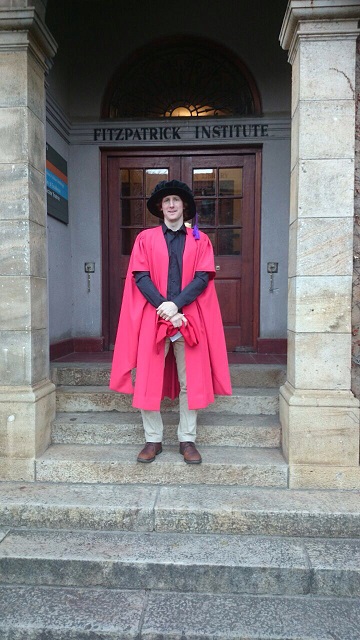Dominic Rollinson has this month been awarded his Doctorate by the University of Cape Town (UCT) for his study of seabird bycatch by pelagic longliners in the waters surrounding South Africa.

Graduation day: Dom Rollinson outside the entrance to the FitzPatrick Institute on the University of Cape Town campus
Dom’s thesis research was co-supervised by the award-winning marine ornithologist Peter Ryan of UCT’s Percy FitzPatrick Institute of African Ornithology and Ross Wanless (himself an award-winning ‘Fitztitute’ graduate from Peter’s stable), now with BirdLife South Africa.
The thesis abstract follows:
“Seabirds are considered one of the most threatened groups of birds in the world. They face additional mortality both on their breeding islands from introduced predators and at sea by fishing fleets, as fisheries bycatch, as well as other human impacts. Seabird bycatch has negatively affected many seabird populations worldwide, with trawl, gillnet and longline fisheries considered the most destructive to seabird populations. Seabird bycatch from trawl and gillnet fisheries has been significantly reduced in recent years, but large numbers of seabirds are still killed annually by longline fisheries. Of the two types of longline fisheries (demersal and pelagic), pelagic longlining is considered the most harmful to seabirds as lines remain closer to the surface for longer periods than demersal longlining, and it is harder to weight lines to ensure rapid sinking beyond the depth they are accessible to birds. Seabirds are killed when they swallow baited hooks and consequently drown. Despite the large number of studies investigating seabird bycatch from pelagic longline fisheries, there remain gaps in our understanding of seabird bycatch from pelagic longline fisheries. This thesis addresses some of these knowledge gaps and makes recommendations as to how seabird bycatch from pelagic longliners can be reduced at both a local and global scale.
Chapters 2 and 3 investigate the factors affecting seabird bycatch from pelagic longliners off South Africa, provide a summary of seabird bycatch from the fishery for the period 2006–2013 and quantify the structure of seabird assemblages associated with pelagic longline vessels off South Africa. This was achieved by analysing seabird bycatch data collected by fisheries observers as well as data from sea trials onboard pelagic longliners. Seabird bycatch by pelagic longliners off South Africa over the 8-year study period has been significantly reduced from the 8-year period (1998–2005), mainly driven by a significant reduction in seabird bycatch rates from foreign-flagged vessels, which are responsible for c. 80% of fishing effort off South Africa. Seabird bycatch rates from South African vessels still remain high, four times higher than the interim national target of < 0.05 birds per 1000 hooks. The species composition of seabird bycatch off South Africa is best explained by an understanding of the structure of the seabird assemblage associated with longline vessels. For most species, bycatch and attendance ratios were similar, but for some species such as shy-type and black-browed albatrosses there were large mismatches, likely caused by differences in foraging behaviour and foraging dominance hierarchies.
In Chapters 4 and 5 the foraging ecology of the most commonly recorded bycatch species off South Africa, the white-chinned petrel (Procellaria aequinoctialis), is investigated. An understanding of the foraging ecology of commonly recorded bycatch species enhances our understanding of seabird bycatch and helps to improve the design of current and future mitigation measures. The year-round movements of white-chinned petrels from Marion Island were investigated with Global Location Sensors (GLS loggers) and GPS loggers. Adult white-chinned petrels undertake only limited east-west movements of, with all birds remaining between southern Africa and Antarctica. These results strengthen the theory that there is limited spatial overlap year-round between white-chinned petrel populations from South Georgia, the southern Indian Ocean islands and New Zealand sub-Antarctic islands, suggesting that these populations can be managed as separate stocks. The diving behaviour of white-chinned and grey petrels (P. cinerea), another common bycatch species in Southern Ocean longline fleets, were examined with the use of temperature-depth recorders (TDRs), deployed on birds from Marion Island and Gough Island. My study was the first to analyse TDR dive data from any Procellaria petrel, and recorded them reaching maximum dive depths of 16 and 22 m, respectively. Current best practise suggests that baited hooks be protected to a depth of 5 m by bird-scaring lines, but my results suggest this depth should be increased to at least 10 m.
Although line weighting is a proven mitigation measure to reduce seabird bycatch from pelagic longliners, fishers have concerns that it will compromise fish catches, crew safety and operational efficiency. In Chapter 6 I analyse line weighting data from trials onboard three pelagic longline vessels, to address the concerns of fishermen. My results show that sliding leads can be incorporated into pelagic longline fisheries without compromising fish catch, crew safety or operational efficiency. I thus recommend that sliding leads be used on pelagic longline vessels fishing off South Africa.
By incorporating studies investigating the factors affecting seabird bycatch, seabird foraging ecology and the efficacy of seabird bycatch mitigation measures, my thesis has broadened our understating of seabird bycatch from pelagic longliners and makes meaningful recommendations to further reduce bycatch, both locally and globally. Although seabird bycatch rates have declined off South Africa, through the use of a number [of] different mitigation measures, they still remain higher than the South African national target and thus more work is needed to achieve this target. To reduce seabird bycatch from pelagic longliners to acceptable levels, studies from the world’s various longline fleets needs to be considered and improved upon, with seabird conservationists and fishermen working together to achieve this goal.”
Click here to access a recent publication on seabird bycatch by Dom and his colleagues. His other papers can be accessed from here.
With thanks to Dominic Rollinson.
Reference:
Rollinson, D. 2017. Understanding and Mitigating Seabird Bycatch in the South African Pelagic Longline Fishery. PhD thesis, University of Cape Town, 169 pp.
John Cooper, ACAP Information Officer, 27 July 2017

 English
English  Français
Français  Español
Español